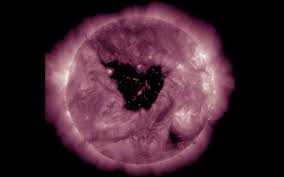Understanding the Butterfly Shaped Hole on the Sun

Introduction
The Sun, our nearest star, is a subject of perpetual fascination and study. Recently, a unique phenomenon known as a ‘butterfly shaped hole’ has been observed on the Sun’s surface. This event has significant implications for our understanding of solar activity, plasma dynamics, and the potential impacts on space weather. Scientists from various institutes are eager to explore these findings as they provide valuable insights into the complex mechanisms driving solar phenomena.
Details of the Observation
On October 3, 2023, the Solar Dynamics Observatory (SDO) captured stunning images showcasing this butterfly shaped hole in the Sun’s corona. The feature is characterized by two distinct lobes that seem to form wings of a butterfly, separated by a narrow central region. This unusual formation is classified as a coronal hole, an area where the Sun’s magnetic field opens up, allowing solar wind to escape into space.
The size of this particular coronal hole is estimated to be over 100,000 kilometers across—a striking reminder of the scale of solar structures. These holes can lead to increased solar wind and may affect space weather conditions, including geomagnetic storms, when the solar wind interacts with Earth’s magnetic field.
Implications for Space Weather
Coronal holes like the butterfly shaped structure are crucial to understanding solar wind dynamics. Solar winds from coronal holes can reach Earth within one to three days, leading to potential disruptions in satellite communications, power grids, and other technologies reliant on delicate electromagnetic interactions. The recent observations provide an opportunity for researchers to enhance predictive models of space weather, which are essential in maintaining the integrity of modern technology.
Conclusion
The discovery of the butterfly shaped hole on the Sun offers an intriguing glimpse into the mysterious and dynamic nature of solar activity. As scientists continue to study this and similar phenomena, we anticipate advancements in our overall understanding of solar dynamics and space weather. This knowledge will not only enhance our predictions of solar events but also help in mitigating the effects of severe space weather on Earth. As technology becomes increasingly dependent on space systems, comprehending our Sun’s behavior remains critically important for the safety and efficacy of our modern digital infrastructure.
